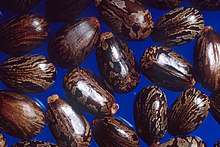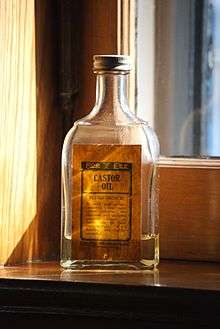Castor oil
Castor oil is a vegetable oil pressed from castor beans.[1] Castor oil is a colourless to very pale yellow liquid with a distinct taste and odor. Its boiling point is 313 °C (595 °F) and its density is 961 kg/m3.[2] It is a triglyceride in which approximately 90 percent of fatty acid chains are ricinoleates. Oleate and linoleates are the other significant components.


Castor oil and its derivatives are used in the manufacturing of soaps, lubricants, hydraulic and brake fluids, paints, dyes, coatings, inks, cold resistant plastics, waxes and polishes, nylon, pharmaceuticals and perfumes.[3]
Etymology
(CASTOR SEED) The name probably comes from a confusion between the Ricinus plant that produces it and another plant, the Vitex agnus-castus.[4][5] However, an alternative etymology suggests that it was used as a replacement for castoreum.[6]
Composition
_V2.svg.png)
Castor oil is well known as a source of ricinoleic acid, a monounsaturated, 18-carbon fatty acid. Among fatty acids, ricinoleic acid is unusual in that it has a hydroxyl functional group on the 12th carbon. This functional group causes ricinoleic acid (and castor oil) to be more polar than most fats. The chemical reactivity of the alcohol group also allows chemical derivatization that is not possible with most other seed oils. Because of its ricinoleic acid content, castor oil is a valuable chemical in feedstocks, commanding a higher price than other seed oils. As an example, in July 2007, Indian castor oil sold for about US$0.90 per kilogram (US$0.41 per pound) whereas U.S. soybean, sunflower and canola oils sold for about US$0.30 per kilogram (US$0.14 per pound).[7]
| Average composition of castor seed oil / fatty acid chains | |
|---|---|
| Acid name | Average Percentage Range |
| Ricinoleic acid | 85–95 |
| Oleic acid | 2–6 |
| Linoleic acid | 1–5 |
| α-Linolenic acid | 0.5–1 |
| Stearic acid | 0.5–1 |
| Palmitic acid | 0.5–1 |
| Dihydroxystearic acid | 0.3–0.5 |
| Others | 0.2– 0.5 |
Uses
Annually 270,000–360,000 tonnes (600–800 million pounds) of castor oil are produced for a variety of uses.[3]
Food and preservative
In the food industry, castor oil (food grade) is used in food additives, flavorings, candy (e.g., polyglycerol polyricinoleate or PGPR in chocolate),[8] as a mold inhibitor, and in packaging. Polyoxyethylated castor oil (e.g., Kolliphor EL)[9] is also used in the food industries.[10]
In India, Pakistan and Nepal food grains are preserved by the application of castor oil. It stops rice, wheat, and pulses from rotting. For example, the legume pigeon pea is commonly available coated in oil for extended storage.
Medicine

Use of castor oil as a laxative is attested to in the circa 1550 BC Ebers Papyrus,[11] and was in use several centuries earlier.[12] The United States Food and Drug Administration (FDA) has categorized castor oil as "generally recognized as safe and effective" (GRASE) for over-the-counter use as a laxative with its major site of action the small intestine where it is digested into ricinoleic acid.[13]
Despite castor oil being widely used in an attempt to induce labor in pregnant women, to date there is not enough research to show whether it is effective to dilate the cervix or induce labor.[14]
Therapeutically, modern drugs are rarely given in a pure chemical state, so most active ingredients are combined with excipients or additives. Castor oil, or a castor oil derivative such as Kolliphor EL (polyethoxylated castor oil, a nonionic surfactant), is added to many modern drugs, including:
- Miconazole, an antifungal agent;[15][16]
- Paclitaxel, a mitotic inhibitor used in cancer chemotherapy;[17]
- Sandimmune (cyclosporine injection, USP), an immunosuppressant drug widely used in connection with organ transplant to reduce the activity of the patient's immune system;[18]
- Nelfinavir mesylate, an HIV protease inhibitor;[19]
- Tacrolimus, an immunosuppressive drug (contains HCO-60, polyoxyl 60 hydrogenated castor oil);
- Xenaderm ointment, a topical treatment for skin ulcers, is a combination of Balsam of Peru, castor oil, and trypsin;[20]
- Aci-Jel (composed of ricinoleic acid from castor oil, with acetic acid and oxyquinoline) is used to maintain the acidity of the vagina.[21]
- Optive Plus (carboxymethylcellulose, castor oil) and Refresh Ultra (glycerine, castor oil), are artificial tears to treat dry eye.[22]
Castor oil is also one of the components of Vishnevsky liniment.[23]
Alternative medicinal use
In naturopathy castor oil has been promoted as a treatment for a variety of human health conditions,[24] including cysts.[25] The claim has been made that applying it to the skin can help cure cancer. However, according to the American Cancer Society, "available scientific evidence does not support claims that castor oil on the skin cures cancer or any other disease."[26]
Skin and hair care
Castor oil has been used in cosmetic products included in creams and as a moisturizer. Small amounts of castor oil are frequently used in cold process soap to increase lathering in the finished bar. It also has been used to enhance hair conditioning [27] in other products and for supposed anti-dandruff properties.[28]
Coatings
Castor oil is used as a bio-based polyol in the polyurethane industry. The average functionality (number of hydroxyl groups per triglyceride molecule) of castor oil is 2.7, so it is widely used as a rigid polyol and in coatings.[1] One particular use is in a polyurethane concrete where a castor-oil emulsion is reacted with an isocyanate (usually polymeric MDI Methylene diphenyl diisocyanate) and a Cement and Construction aggregate. This is applied fairly thickly as a slurry which is self-levelling. This base is usually further coated with other systems to build a resilient floor.[29]
It is not a drying oil, meaning that it has a low reactivity with air compared to oils such as linseed oil and tung oil. Dehydration of castor oil yields linoleic acids, which do have drying properties[1]. In this process, the OH group on the ricinoleic acid along with a hydrogen from the next carbon atom are removed yielding a double bond which then has oxidative cross-linking properties yielding the drying oil.
Precursor to industrial chemicals
Castor oil can be broken down into other chemical compounds that have numerous applications.[30][31][32] Transesterification followed by steam cracking gives undecylenic acid, a precursor to specialized polymer nylon 11, and heptanal, a component in fragrances.[33] Breakdown of castor oil in strong base gives 2-octanol, both a fragrance component and a specialized solvent, and the dicarboxylic acid sebacic acid. Hydrogenation of castor oil saturates the alkenes, giving a waxy lubricant.[1] Castor oil may be epoxidized by reacting the OH groups with Epichlorohydrin to make the triglycidyl ether of castor oil which is useful in epoxy technology.[34] This is available commercially as Heloxy.[35]
The production of lithium grease consumes a significant amount of castor oil. Hydrogenation and saponification of castor oil yields 12-hydroxystearic acid which is then reacted with lithium hydroxide or lithium carbonate to give high performance lubricant grease.[36]
Since it has a relatively high dielectric constant (4.7), highly refined and dried castor oil is sometimes used as a dielectric fluid within high performance high voltage capacitors.
Lubrication
Vegetable oils like castor oil are typically unattractive alternatives to petroleum-derived lubricants because of their poor oxidative stability.[37][38] Castor oil has better low-temperature viscosity properties and high-temperature lubrication than most vegetable oils, making it useful as a lubricant in jet, diesel, and racing engines.[39] The viscosity of castor oil at 10 °C is 2,420 centipoise.[40] However, castor oil tends to form gums in a short time, and therefore its usefulness is limited to engines that are regularly rebuilt, such as racing engines. The lubricant company Castrol took its name from castor oil.
Castor oil has been suggested as a lubricant for bicycle pumps because it does not degrade natural rubber seals.[41]
Early aviation and aeromodelling

Castor oil was the preferred lubricant for rotary engines, such as the Gnome engine after that engine's widespread adoption for aviation in Europe in 1909. It was used almost universally in rotary engined Allied aircraft in World War I. Germany had to make do with inferior ersatz oil for its rotary engines, which resulted in poor reliability.[42][43][44]
The methanol-fueled two-cycle glow plug engines used for aeromodelling, since their adoption by model airplane hobbyists in the 1940s, have used varying percentages of castor oil as a lubricant. It is highly resistant to degradation when the engine has its fuel-air mixture leaned for maximum engine speed. Gummy residues can still be a problem for aeromodelling powerplants lubricated with castor oil, however, usually requiring eventual replacement of ball bearings when the residue accumulates within the engine's bearing races. One British manufacturer of sleeve valved four-cycle model engines has stated the "varnish" created by using castor oil in small percentages can improve the pneumatic seal of the sleeve valve, improving such an engine's performance over time.
Turkey red oil
Turkey red oil, also called sulphonated (or sulfated) castor oil, is made by adding sulfuric acid to vegetable oils, most notably castor oil.[45] It was the first synthetic detergent after ordinary soap. It is used in formulating lubricants, softeners, and dyeing assistants.[45]
Biodiesel
Castor oil, like currently less expensive vegetable oils, can be used as feedstock in the production of biodiesel. The resulting fuel is superior for cold winters, because of its exceptionally low cloud and pour points.[46]
Initiatives to grow more castor for energy production, in preference to other oil crops, are motivated by social considerations. Tropical subsistence farmers would gain a cash crop.[47]
Punishment
Some parents punished children with a dose of castor oil.[48][49] Physicians recommended against the practice because they did not want medicines associated with punishment.[50]
A heavy dose of castor oil could be used as a humiliating punishment for adults. Colonial officials used it in the British Raj (India) to deal with recalcitrant servants.[51] Belgian military officials prescribed heavy doses of castor oil in Belgian Congo as a punishment for being too sick to work.[52]
The most famous use as punishment came in Fascist Italy under Benito Mussolini. It was a favorite tool used by the Blackshirts to intimidate and humiliate their opponents.[53][54][55] Political dissidents were force-fed large quantities of castor oil by Fascist squads. This technique was said to have been originated by Gabriele D'Annunzio or Italo Balbo.[56] Victims of this treatment did sometimes die, as the dehydrating effects of the oil-induced diarrhea often complicated the recovery from the nightstick beating they also received along with the castor oil; however, even those victims who survived had to bear the humiliation of the laxative effects resulting from excessive consumption of the oil.[57] It is believed that the Nazi SA used this torture method against German Jews shortly after the appointment of Adolf Hitler as Chancellor of Germany in 1933.[58]
It is said that Mussolini's power was backed by "the bludgeon and castor oil".[57] In lesser quantities, castor oil was also used as an instrument of intimidation, for example, to discourage civilians or soldiers who would call in sick either in the factory or in the military. It took decades after Mussolini's death before the myth of castor oil as a panacea for a wide range of diseases and medical conditions was totally demystified, as it was also widely administered to pregnant women and elderly or mentally ill patients in hospitals in the false belief it had no negative side effects.
Today, the Italian terms manganello and olio di ricino, even used separately, still carry strong political connotations (especially the latter). These words are still used to satirize patronizing politicians, or the authors of disliked legislation. They should be used with caution in common conversation. The terms Usare l'olio di ricino, ("to use castor oil") and usare il manganello ("to use the bludgeon") mean "to coerce or abuse", and can be misunderstood in the absence of proper context.
Also in Greece, during the 4th of August Regime, castor oil was used as a form of punishment.[59]
Safety
The castor seed contains ricin, a toxic lectin. Heating during the oil extraction process denatures and deactivates the lectin. However, harvesting castor beans may not be without risk.[60] The International Castor Oil Association FAQ document states that castor beans contain an allergenic compound called CB1A. This chemical is described as being virtually non-toxic but has the capacity to sensitize people with hypersensitivity. The allergen may be neutralized by treatment with a variety of alkaline agents. The allergen is not present in the castor oil itself. These health issues, in addition to concerns about the toxic byproduct (ricin) from castor oil production, have encouraged the quest for alternative sources for hydroxy fatty acids.[61][62] Alternatively, some researchers are trying to genetically modify the castor plant to prevent the synthesis of ricin.[63]
Since castor oil is sometimes used to induce labor in full-term pregnancies (scientific evidence of its effectiveness is lacking),[64] consuming castor oil to treat constipation is not considered safe in pregnancies that are not at full term yet, as it may cause contractions of the womb.[65]
References
- Thomas, Alfred (2005). "Fats and Fatty Oils". Ullmann's Encyclopedia of Industrial Chemistry. Weinheim: Wiley-VCH. doi:10.1002/14356007.a10_173. ISBN 978-3527306732.
- Aldrich Handbook of Fine Chemicals and Laboratory Equipment. Sigma-Aldrich. 2003.
- Mutlu, H; Meier, MAR (January 2010). "Castor oil as a renewable resource for the chemical industry". European Journal of Lipid Science and Technology. 112 (1): 10–30. doi:10.1002/ejlt.200900138.
- "The Castor Bean: A Plant Named After A Tick". Wayne's Word: An Online Textbook of Natural History. March 1999. Retrieved 2020-04-26.
- Irene Jacob, "Ricinus Communis — The Miracle Tree through Four Thousand Years", The Healing Past: Pharmaceuticals in the Biblical and Rabbinic World, ed. Irene and Walter Jacob (Brill, 1993), 81-93.
- Casselman, William Gordon. "Castor". Bill Casselman's Canadian Word of the Day. Archived from the original on 2011-02-03. Retrieved 2014-08-09.
- "Seed Oil Prices" (PDF). United States Department of Agriculture. July 2007. p. 31. Archived from the original (PDF) on April 6, 2008. Retrieved 2008-08-10.
- Wilson, R; Van Schie, BJ; Howes, D (1998). "Overview of the preparation, use and biological studies on polyglycerol polyricinoleate (PGPR)". Food and Chemical Toxicology. 36 (9–10): 711–8. doi:10.1016/S0278-6915(98)00057-X. PMID 9737417.
- Safety datawsheet cremophor El Castor Oil http://www.sfm.state.or.us/cr2k_subdb/msds/cremophor_el_castor_oil.pdf Archived 2017-12-06 at the Wayback Machine
- Busso, C; Castro-Prado, MA (March 2004). "Cremophor EL stimulates mitotic recombination in uvsH//uvsH diploid strain of Aspergillus nidulans". Anais da Academia Brasileira de Ciências. 76 (1): 49–55. doi:10.1590/S0001-37652004000100005. PMID 15048194.
- Bryan, Cyril P. (1930). The Papyrus Ebers, Translated from the German Version By Cyril P. Bryan (PDF). London: Geoffrey Bles. p. 44. Archived from the original (PDF) on 2013-09-21.
- Bryan, p. xvii
- "Ingredient List A-C" (PDF). FDA (see page 52 of this link). Archived from the original (PDF) on 2006-12-17. Retrieved 2006-12-28.
- Kelly, AJ; Kavanagh, J; Thomas, J (2013). "Castor oil, bath and/or enema for cervical priming and induction of labour". Cochrane Database of Systematic Reviews (7): CD003099. doi:10.1002/14651858.CD003099.pub2. PMC 7138266. PMID 23881775.
- Marmion, LC; Desser, KB; Lilly, RB; Stevens, DA (September 1976). "Reversible thrombocytosis and anemia due to miconazole therapy". Antimicrobial Agents and Chemotherapy. 10 (3): 447–9. doi:10.1128/aac.10.3.447. PMC 429768. PMID 984785. See page 1, Methods and Materials.
- Fromtling, RA (1 April 1988). "Overview of medically important antifungal azole derivatives". Clinical Microbiology Reviews. 1 (2): 187–217. doi:10.1128/CMR.1.2.187. PMC 358042. PMID 3069196. See page 6, /192, Clinical studies
- Micha, JP; Goldstein, BH; Birk, CL; Rettenmaier, MA; et al. (February 2006). "Abraxane in the treatment of ovarian cancer: the absence of hypersensitivity reactions". Gynecologic Oncology. 100 (2): 437–8. doi:10.1016/j.ygyno.2005.09.012. PMID 16226797.
- "Sandimmune ingredients". DailyMed. Retrieved 2007-01-06.
- Zhang, KE; Wu, E; et al. (April 2001). "Circulating metabolites of the human immunodeficiency virus protease inhibitor nelfinavir in humans: Structural identification, levels in plasma, and antiviral activities". Antimicrobial Agents and Chemotherapy. 45 (4): 1086–93. doi:10.1128/AAC.45.4.1086-1093.2001. PMC 90428. PMID 11257019.
- Beitz, JM (June 2005). "Heparin-induced thrombocytopenia syndrome bullous lesions treated with trypsin-balsam of peru-castor oil ointment: A case study". Ostomy Wound Manage. 51 (6): 52–4, 56–8. PMID 16014993.
- "Aci-Jel (Vaginal Jelly) drug description". RxList. Archived from the original on 2007-10-08. Retrieved 2007-10-26.
- Pucker AD, Ng SM, Nichols JJ (2016). "Over the counter (OTC) artificial tear drops for dry eye syndrome". Database Syst Rev. 2: CD009729. doi:10.1002/14651858.CD009729.pub2. PMC 5045033. PMID 26905373.
- Charman, C. (12 June 1999). "Vishnevsky liniment and ichthammol: on the perspectives of application in military medicine and other fields". The BMJ. 318 (7198): 1600–1604. doi:10.1136/bmj.318.7198.1600. PMC 1115970. PMID 10364122. Retrieved 5 July 2016.
- "Castor Oil Health Benefits". homeremediesweb.com. Retrieved 2015-10-02.
- "Science Based Castor Oil Benefits, Uses & Side Effects". June 2019. Retrieved 4 July 2020.
- "Castor Oil". American Cancer Society. March 2011. Archived from the original on 2013-02-09. Retrieved 2013-09-22.
- "Hair Growth with Castor Oil. Cold Pressed Castor oil Enhances Hair & Stops the Baldness!".
- , Zofchak, Albert; John Obeji & Michael Mosquera, "Use urethane polymers of castor oil skin and personal care product compositions"
- Howarth, GA (June 2003). "Polyurethanes, polyurethane dispersions and polyureas: Past, present and future". Surface Coatings International Part B: Coatings Transactions. 86 (2): 111–118. doi:10.1007/bf02699621. ISSN 1476-4865.
- "Multiple uses of castor oil". Retrieved 2007-08-02.
- Mutlu, Hatice; Meier, Michael A. R. (2010-01-25). "Castor oil as a renewable resource for the chemical industry". European Journal of Lipid Science and Technology. 112: 10–30. doi:10.1002/ejlt.200900138.
- Ogunniyi, D.S. (June 2006). "Castor oil: A vital industrial raw material". Bioresource Technology. 97 (9): 1086–91. doi:10.1016/j.biortech.2005.03.028. PMID 15919203.
- Ashford's Dictionary of Industrial Chemicals, Third edition, 2011, page 6162
- Hermansen, Ralph D. (2017-03-16). Polymeric Thermosetting Compounds: Innovative Aspects of Their Formulation Technology. CRC Press. ISBN 9781771883153.
- Ash, Michael; Ash, Irene (2007). Handbook of fillers, extenders, and diluents (2nd ed.). Endicott, NY: Synapse Information Resources. p. 82. ISBN 9781890595968.
- Kirk-Othmer Encyclopedia of Chemical Technology. Archived from the original on July 14, 2011. Retrieved 2010-07-12.
- "Chemical modification to improve vegetable oil lubricants". Retrieved 2007-08-02.
- "Petroleum Oil and the Environment". DOE. Retrieved 2006-12-28.
- McGuire, Nancy (2004). "Taming the Bean". The American Chemical Society. Archived from the original on September 27, 2006. Retrieved 2007-08-02.
- Brady, George S.; Clauser, Henry R.; Vaccari, John (1997). Materials Handbook (14th ed.). New York: McGraw-Hill. ISBN 978-0070070844.
- Older, Jules (2000). Backroad and Offroad Biking. Mechanicsburg, PA: Stackpole Books. p. 37. ISBN 978-0811731508.
- Guilmartin, John F., Jr. (1994). "Technology and Strategy: What Are the Limits?". Two Historians in Technology and War. United States Army War College, Strategic Studies Institute. p. 10. ISBN 978-1428915220.
- Fisher, Suzanne Hayes (1999). "Aircraft, production during the war". In Tucker, Spencer C.; Wood, Laura Matysek; Murphy, Justin D. (eds.). The European Powers in the First World War: An Encyclopedia. Taylor & Francis. p. 10. ISBN 978-0815333517.
- U.S. Tariff Commission (1921). Tariff Information Surveys on the Articles in Paragraphs 44 and 45 of the Tariff Act of 1913. Washington, D.C.: Government Printing Office. p. 40.
- Penda, H (2017). Herbal Soaps & Detergents Handbook. Delhi, India: NIIR. p. 121. ISBN 9789381039007.
- Biodiesel from Castor Oil: A Promising Fuel for Cold Weather (PDF) Archived June 16, 2013, at the Wayback Machine by Carmen Leonor Barajas Forero, 2004-10-12. Retrieved 2012-01-24.
- The Promise of the Castor Bean Archived March 9, 2016, at the Wayback Machine by Elizabeth Johnson, Biodiesel Magazine, 2004-12-01. Retrieved 2012-01-24.
- For an American example see David J. Rothman (1980). Conscience and Convenience: The Asylum and Its Alternatives in Progressive America. Transaction Publishers. p. 279. ISBN 9780202365091. Retrieved 2015-10-29.
- For a Canadian examples see Neil Sutherland (1997). Growing Up: Childhood in English Canada from the Great War to the Age of Television. University of Toronto Press. p. 87. ISBN 9780802079831. Retrieved 2015-10-29.
- Journal of the American Medical Association. American Medical Association. 1919. p. 1699. Retrieved 2015-10-29.
- Cecilia Leong-Salobir (2011). Food Culture in Colonial Asia: A Taste of Empire. Taylor & Francis. p. 66. ISBN 9781136726545.
- Adam., Hochschild (1999). King Leopold's ghost : a story of greed, terror, and heroism in Colonial Africa (1st Mariner books ed.). Boston: Houghton Mifflin. p. 166. ISBN 978-0547525730. OCLC 759834634.
- "Italy The rise of Mussolini". Encyclopædia Britannica Online. Encyclopædia Britannica. 2007. Archived from the original on October 14, 2007. Retrieved 2007-08-03.
- "Benito's Birthday". Time, in partnership with CNN. August 6, 1923. Retrieved 2007-08-03.
- Bosworth, R. J. B. (2002). Mussolini. New York: Arnold/Oxford Univ. Press. ISBN 978-0-340-73144-4.
- "Bearded like a medieval condottiere, bluff yet suave, fearless and supple, [Italo Balbo] was not the type to pass unnoticed anywhere. His admirers here chose to forget the Blackshirt club-wielder and reputed inventor of the castor-oil treatment for Fascist foes"
Marshal Balbo, The New York Times, July 1, 1940, p. 18. - Cecil Adams (1994-04-22). "Did Mussolini use castor oil as an instrument of torture?". The Straight Dope. Retrieved 2014-08-09.
- Evans, Richard J (2004). The Coming of the Third Reich: How the Nazis Destroyed Democracy and Seized Power in Germany. USA: Penguin Books. p. 431. ISBN 978-1-101-04267-0.
- Σπύρος Λιναρδάτος, 4η Αυγούστου, Ε' έκδοση, Εκδ. Θεμέλιο, 1988, σελ. 63
- Auld, DL; Pinkerton, SD; Rolfe, R; Ghetie, V; et al. (March–April 1999). "Selection of castor for divergent concentrations of ricin and ricinus communis agglutinin". Crop Science. 39 (2): 353–7. doi:10.2135/cropsci1999.0011183X003900020008x. Archived from the original on 2008-10-12. Retrieved 2007-07-31.
- Dierig, David A. (1995). "Lesquerella". New Crop FactSHEET. Center for New Crops & Plant Products, at Purdue University. Retrieved 2007-08-01.
- Sources of Hydroxy Fatty Acids https://naldc-legacy.nal.usda.gov/naldc/download.xhtml?id=IND93048066&content=PDF
- Wood, M (2001). "High-tech castor plants may open door to domestic production". Agricultural Research Magazine. 49 (1). Retrieved 2007-08-02.
- Boel, ME; Lee, SJ; Rijken, MJ; Paw, MK; Pimanpanarak, M; Tan, SO; Singhasivanon, P; Nosten, F; McGready, R (October 2009). "Castor oil for induction of labour: not harmful, not helpful". Australian and New Zealand Journal of Obstetrics and Gynaecology. 49 (5): 499–503. doi:10.1111/j.1479-828x.2009.01055.x. PMID 19780733.
- "Drugs and Supplements: Laxative (Oral Route)". Mayo Clinic. Retrieved 15 May 2015.
Further reading
- Naughton, Frank., "Castor Oil", Kirk-Othmer Encyclopedia of Chemical Technology, New York: John Wiley, doi:10.1002/0471238961.0301192014012107.a01.pub2, ISBN 9780471238966 – overview of chemical properties and manufacturing of castor oil